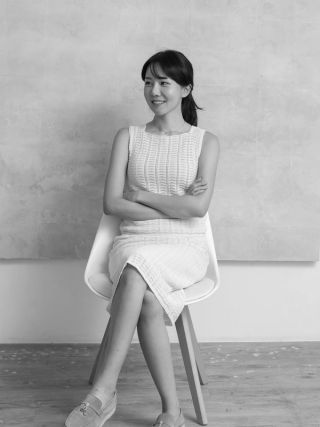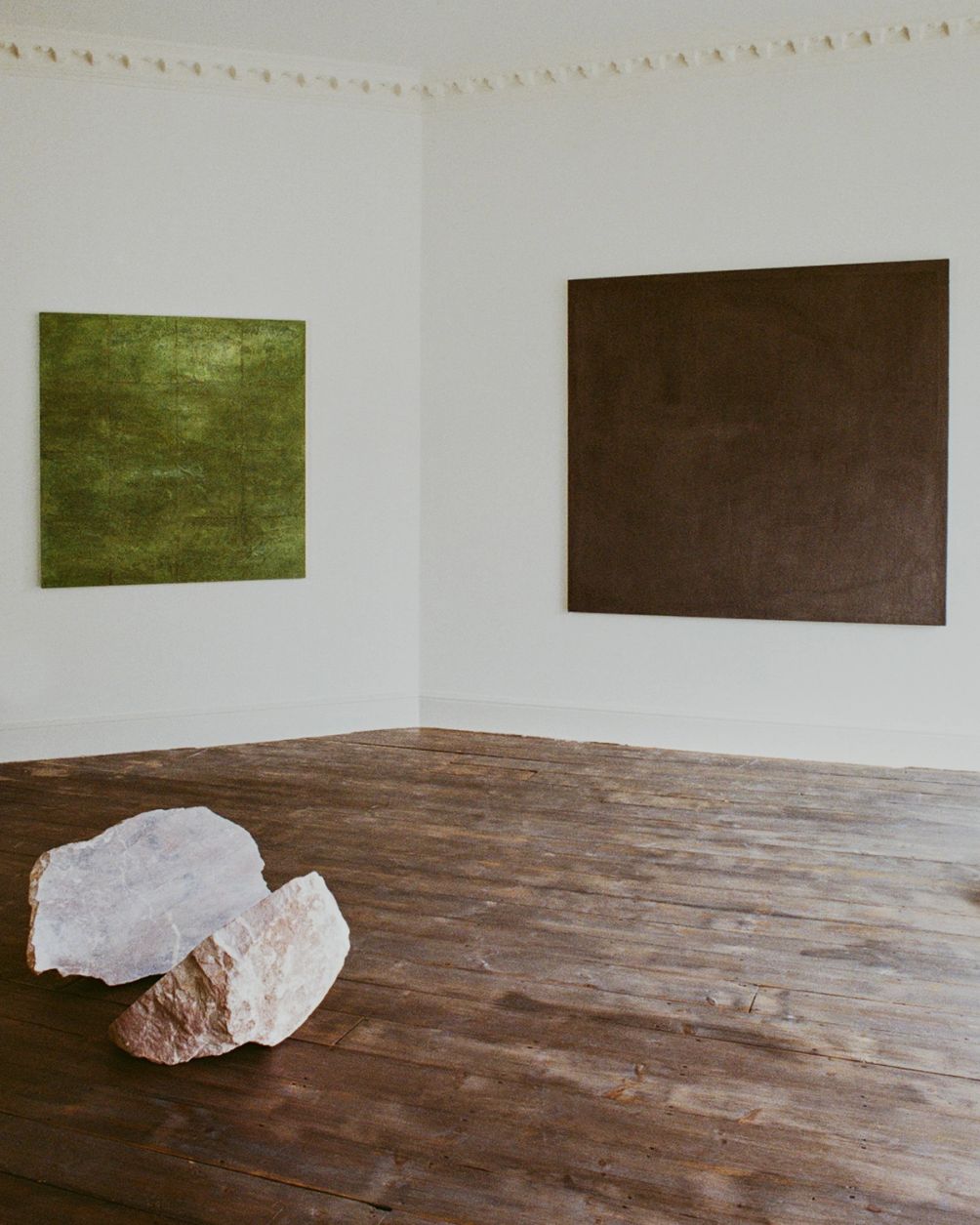Group Exhibition: AtmosphereNov 4, 2023 – Jan 20, 2024
The works of multimedia artist Armando Chant, sculptor Samuel Collins, and painters Bo Kim and Will Calver share a sensitivity to atmosphere, to space between objects, and an exploration of depth, layering, opacity and translucency.
In his linen embroidery, pigment washes, and etchings in aluminium plate, Sydney-based Armando Chant produces subtle abstractions which, when viewed closely, reveal the faint impression of a landscape: the contours of the linen stitch become a mountain’s ridges, the dark graphite dye the deep chasms in the rock. Chant takes vintage stereoscope glass negatives from the early 1900s as his starting point, and erases the specificity of place until an ambiguous depiction remains. “It’s like looking at a landscape at night: you know there’s something there, but you can’t quite make out the details – this is the kind of understanding of place I’m concerned with,” he says. “They are inspired by the late works of Turner and Hiroshi Sugimoto’s Seascape series: indeterminate works that almost conjure a veil between themselves and the viewer.”
Arranged on the gallery floor, enigmatic sculptures in Dorset limestone, Purbeck marble and English alabaster evoke their own elemental landscapes in dialogue with that of Chant’s suggestive depictions. “Stone offers itself to a soft, low-lit setting; once you bring a piece inside, it instantly changes the feeling of a room,” says British sculptor Samuel Collins. “When I work on a piece, I am always careful not to polish the surface too highly. I want to allow the light to be absorbed into the stone, rather than refracted away, and let the shadow linger on its surface a little longer.” The resulting works have inherent relationships with vertical or horizontal landscapes, and marry the tactile, essential appeal of found objects with the refined form of sculpture. In his patient cutting and sanding, excavating the sculpture’s form from the stone, Collins’s pieces exhibit a similar method of erasure to Chant’s landscapes.
Three still lifes are presented in the show, composed by British artist Will Calver, in oil on panel with traditional techniques dating from the 17th century. The domestic subjects – a peeled lemon beside a ceramic pitcher, a bowl of apricots on a wooden table – are expressed with a delicate, shimmering effect as if the subjects were viewed from a great distance. “I like paying attention to the visual noise created by the earth’s atmosphere and emphasising the sense of air between the viewer and the object,” he says. “I enjoy the paradoxical idea that a seemingly still object is composed of particles that are in constant motion. By playing on these visual mechanisms, the paintings become concerned with the act of seeing.”
In conversation with Chant’s landscapes, Calver’s still lifes and Collins’s sculptures are four works by Korean artist Bo Kim. The pieces are part of two of her ongoing series, When Light Is Put Away and Imperfection. In each piece, multiple layers of hanji are built up and combined with washes of paint and sand, creating richly detailed surfaces of varying depths, textures and tones, suggestive of a hazy sky reflected in a stream or the intermingling of moss and algae on a forest floor. “When I glue the layers of hanji, sometimes wrinkles and creases form, revealing the layer beneath, which I accept as the beauty of imperfection,” she says. “In Korean culture, valuing the beauty of imperfection signifies a reverence for nature and an acceptance of natural forms.” During the composition of her When Light Is Put Away series, Kim often takes a memory of a skyscape as her starting point, which she records as thoughts and sketches in her diary. The titles are often inspired by a line in a poem or song encountered during the day of its making. In remembering, Kim creates an altered and abstracted vision, much like Chant’s obscured landscapes or the exaggerated blur of Calver’s still lifes.
The built-up layers of fibrous hanji, textured sand and paint in Kim’s works echo those of Chant’s, where multiple layers of washes, varying in thickness and material, are applied to the linen embroidery. Collins’s sculpting of stone can be thought of as an act of exposing layers of geological time, while Calver’s still lifes, in following the traditions of 17th century Dutch painting, are composed in the indirect method of three distinct layers of pigment. All share a degree of relief in their surface and prompt an attentive inquiry into their texture, requiring an engagement from the viewer that goes beyond an immediate visual impression. This tactile gaze that assesses their softness, weight, density, and hidden depth.
Words
- Ollie Horne
Photos
- Milo Reid
Featured Artists
- Armando Chant

Combining embroidered linen with pigment washes and etching, Chant uses techniques of erasure and negation to arrive at ambiguous, atmospheric landscapes. His work focuses on the inherent potential of the in-between, a place of imaginative engagement and a nascent state of emergence.
- Bo Kim

Kim lives and works in Seoul and studied at Rhode Island School of Design, gaining a BFA in painting and an MA in teaching. Her work celebrates imperfection, which, in Korean culture, implies respect for nature, honoring its natural forms.
- Samuel Collins

Favouring the direct carving method of Barbara Hepworth and Henry Moore, Collins works immediately into the stone, hewing simple gestures, arrangements and movements while reconciling irregularities and imperfections in the material to arrive at the final form.
- Will Calver

In studying the interactions between light, form and colour, British artist Will Calver’s still lifes convey the quietude and subtle monumentality of everyday objects.
Related exhibitions

Although Korea is known as ‘The Land of Morning Calm’, this name is a mistranslation. The result of ancient Korean, and its spoken dialects, haphazardly translated into Chinese characters many centuries ago, the sobriquet more faithfully speaks to the instability of meaning and its susceptibility to time and place. Francis Gallery’s inaugural show, Morning Calm, takes this ambiguity as a point of entry into the idea of Korea, and its multitudes. In the exhibition, six artists of Korean and Korean American descent explore Korea and Koreanness as composites of memory, imagination, history, and feeling. Produced by artists at different stages of their careers, working in both Korea and the United States, the artworks reinterpret traditional Korean objects, materials, techniques, and rituals in modern, hybrid expressions.

Though the phrase Bap meogeosseoyo? (밥먹었어요?) directly translates to “Have you eaten?”, it is a common greeting in Korean—a time-honored way of asking how someone is doing. Bap, meaning rice or a meal, frequently appears in Korean expressions, reflecting the cultural emphasis on nourishment as a foundation of being. The phrase is also deeply Korean in its politeness: its mundane and specific nature respects the boundaries of privacy while inviting a range of responses. Making use of this as a title, Have you eaten today? draws our attention to eating as one of the most fundamental acts of care, and an intimate form of relating to the world.









